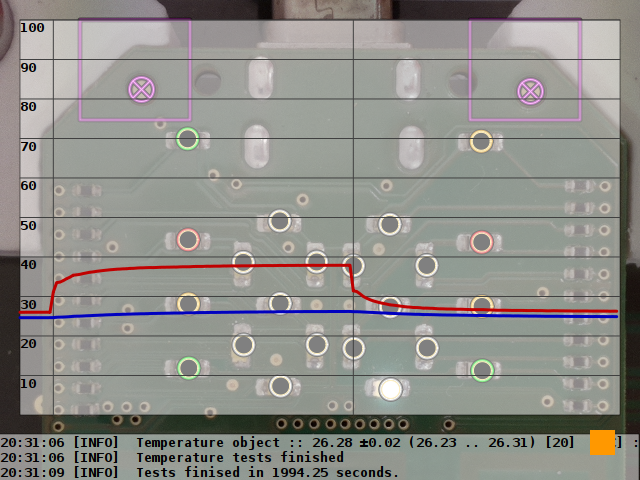Cryptoucan™ safety testing
Written by Dominik Joe Pantůček on 2019-01-10
cryptoucanAlthough Cryptoucan™ is a cryptographic - security - device, it contains delicate electric circuitry and certain electronic components can produce significant amount of heat should there be any soldering problem. Therefore the device safety is also of utmost importance for us. Read on to see how we make sure no short circuit heats up more than it should.
In addition to functional testing of the device[1] that includes testing the soldered PCBs display and USB communication capabilities the testing process measures all possible physical properties that can be measured and that might affect the device electrical stability and safety.
When designing the test jig and formulating the whole testing process, we focused mainly on the following parameters:
-
USB power supply voltage,
-
USB power consumption,
-
on-board voltages for important parts of the PCB, and
-
ambient and component temperatures.
These tests actually cover some security aspects as well. It is important that during cryptographic operations the device does not leak secret material via any side channel like voltage or current fluctuations[2]. That is one of the reasons why we measure all voltages, currents and temperatures. The second reason is the user safety.
The duration of complete testing round is more than two minutes and with measurement sensors in the very vicinity of certain components we can quickly see - and automatically detect - whether everything is in order. Certain parts of the testing are very power intensive and this allows us to see how the local components temperatures converge to its maximum. We are also able to compare this temperature to the ambient air temperature nearby and immediately see if it matches the physical model of heat dispersion[3].
Then, after stopping the power-intensive operations, we can see - as in Picture 1 below - the exponential drop of temperature and convergence to the ambient air temperature. And once again, as the testing progresses, we compare this to the physics model and the testing software can check whether it is in safe limits in real time!

Picture 1: Temperature measurements during power-intensive operations and after stopping them. When you connect your USB flash drive[4] and start constantly writing new data to it, you can quickly see - or more likely feel - its temperature rising. Try it for yourself and touch it. Some USB devices produce more heat than they should during certain operations. You should ask yourself - did the manufacturer do all the safety tests that should have been done? We do, because security and safety should go hand in hand!
Thank you for following Cryptoucan™ development and come back next week for more!
References
-
https://trustica.cz/en/2018/12/06/cryptoucan-pcb-visual-control/
-
https://trustica.cz/en/2018/07/05/cryptoucan-development-electronic-refinements/
-
Wikipedia contributors. (2019, January 2). Heat transfer. In Wikipedia, The Free Encyclopedia. Retrieved 20:51, January 10, 2019, from https://en.wikipedia.org/w/index.php?title=Heat_transfer&oldid=876422789
-
Wikipedia contributors. (2019, January 10). USB flash drive. In Wikipedia, The Free Encyclopedia. Retrieved 20:59, January 10, 2019, from https://en.wikipedia.org/w/index.php?title=USB_flash_drive&oldid=877771132
